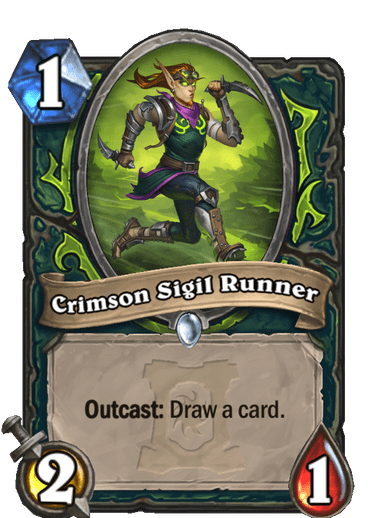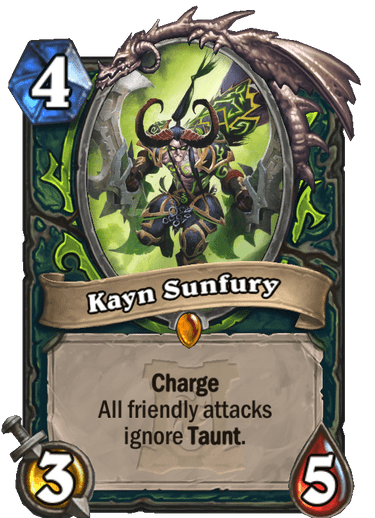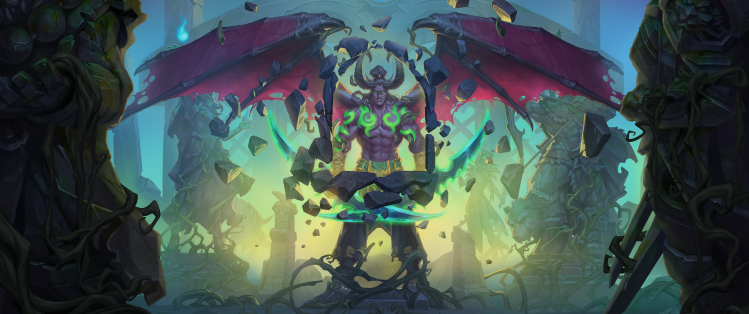Hearthstone‘s latest expansion, Ashes of Outland, released this week for PC and mobile. With it comes one of the most exciting additions to Blizzard Entertainment’s digital card game since it launched back in 2014: a new class.
Demon hunters enter the Hearthstone fray as an aggressive class with a focus on drawing cards and attacking with your hero. It’s a class that has a long history in Warcraft lore, with the night elf Illidan (turned part-demon through a dark ritual) showing up as the first demon hunter in 2002. Demon hunters then became a playable class in World of Warcraft with the Legion expansion in 2016.
I interviewed Hearthstone game director Ben Lee before the launch of the set about the challenges of adding a new class to the game, and why the team went with the demon hunter. And if you want to learn even more about the new class, check out our other recent Hearthstone interview.
Picking demon hunter
GamesBeat: There are three World of Warcraft classes that aren’t playable in Hearthstone: death knights, monks, and demon hunters. Why did demon hunter rise to the top?
Ben Lee: The team had already done their take on death knights in the Frozen Throne expansion. That ship sailed a little bit at least, for a significant amount of time. When thinking about what set we wanted to do, we wanted to do something we thought would be really big, really impactful. Outland and Burning Crusade are some of the most beloved time periods of the Warcraft license. Outland was something we were keen and happy to pursue. The natural fit for that would be demon hunter and Illidan as a character. Illidan is the title villain of the Burning Crusade expansion. It seemed like the perfect fit. Obviously demon hunters themselves, it’s a super-cool, really interesting class. For many players it’s their favorite class, even going back to the Warcraft III heroes in the campaign game there. Of the different choices we had, it seemed like right one at the right time.
GamesBeat: Are you telling me that monks will happen before death knights next?
Lee: Well, who knows?
GamesBeat: Did you want to give Illidan some redemption in Hearthstone? He’s been a legendary card since the beginning, but not a super-powerful one. Was it nice to make him more prominent?
Lee: Yeah, for sure. For me, I love the Warcraft license. It’s been hugely influential in my life and in my career. Doing proper justice to these big characters is important to me and to the team. We’re happy with how the demon hunter and Illidan have turned out. Very shortly players are going to be able to play it, and hopefully they’ll enjoy it.
GamesBeat: I know it can be challenging to establish an identity for each of the classes you already had. Was it hard to come up with a whole new class identity for a new class?
Lee: Yes and no. Class identity is important, but a lot of that comes through in terms of theming in art and effects and sound. There are some classes that have very specific mechanics, like Outcast is a demon hunter only mechanic. We can give them something that plays up their agility, their movement-based play style in the other games. It’s a mixture of different things. When you think about paladins, as an example, a lot of their flavor comes through in their artwork. There’s a lot of the holy light kinds of effects and colors, the yellows within their expansion sets.
It’s a big mixture of different factors. We’re happy with how it turned out with demon hunter. They have a few different varied playstyles that we think will emerge throughout the year. It’s probably going to trend more toward the fast play styles at the beginning, in the first expansion, but throughout the year we expect them to develop some token synergies, some big demon synergies. We’re happy with it. It also gives us a clean slate. If you look back at Hearthstone, it’s been six years since launch. A lot has changed. Our current team’s vision of class identities, compared to the original game, can be a bit different in some places. It’s hard to retroactively fix all these different things. With a new class it’s been exciting and interesting and fun for the team to be able to do that.
New hero, new tools
GamesBeat: The Outcast keyword, where it depends on whether the card is on the left or right in your hand, was that something you created when you wanted to do demon hunters, or is it a mechanic you were working with before you settled on bringing demon hunters to the game?
Lee: During the early phase of the expansion, the team was playing with a number of different mechanics and ideas. This was something they were thinking about — I think originally it was just a general mechanic we were trying. Then the team felt that it was very thematic for demon hunter. It felt like a good fit, and we kept it limited to them. For me personally, sometimes having a very unique mechanic for a class is interesting. If you look at rogue, the combo mechanic feels like something rogues would do. Secrets feel quite thematic for hunter and mage specifically. We’re happy we settled on it. It felt just like the right thing for Illidan and for demon hunter.

Above: Crimson Sigil Runner.
GamesBeat: How hard was it to develop the new hero power? Were there a lot of iterations before you settled on the one we have?
Lee: There were. The hero power might be the most challenging we did. For people that are reading this, it might seem really simple. It’s just 1 mana, 1 attack. Hero powers are really nuanced, though. They impact the game a huge amount. We don’t want them to impact the game too much, but we want them to impact the game enough. We’re a card game. We want you to be playing cards, not just using the hero power. We tried various different things. One idea we tried was it made your attacks avoid taunt, which sounds absolutely broken, but in practice it turned out to not be that useful. It depends on who you’re playing against, but often your enemy’s minions don’t even have taunt. It’s just a negligible bonus. In situations where you could use it, it just felt bad to be able to do that all the time on demand. It’s kind of a feast or famine idea. That’s not where we want hero powers to lie. We want it to be a consistent extra value if you have the excess mana to be able to do it.
We wanted to do something with attacking, though. That was consistent from the start. We wanted the demon hunter to pick up off the board, attack enemy minions or attack the enemy hero. If you’ve seen Illidan in Heroes of the Storm or Warcraft III or even World of Warcraft, he’s super agile, jumping around. Demon hunters have huge movement-based kit in their games. We wanted to fulfill that fantasy for demon hunter. Attacking was our allegory for that. The 1 mana idea is something that came pretty late in, but it felt right. It’s something you can do often. You can always get into the thick of the action as a demon hunter. At the beginning of the battle you can jump forward and attack before anyone else gets a chance. It felt right, and we’re super happy with it.
GamesBeat: Was it difficult to find a way to get these new basic demon hunter cards to players? I know that was always the question that was raised when people talked about new classes: Are people going to buy Classic packs again and get all these duplicates? How did you settle on the delivery service that you came up with?
Lee: In terms of how players get them, the first thing we wanted to make sure of was that getting the demon hunter hunter class would be free. Introducing a new class to the game, we want that class to be played, obviously. We want people to have fun and get into the action immediately. Having a barrier, a financial barrier to entry is the worst thing in that case. It also just means that if you want to play this new character, you have to fork over either a lot of time or money or whatever may be the case, and we didn’t want that. We wanted demon hunter to be impactful, be big, be fun, be something players can log into the game and get access to as soon as possible. But we wanted to do a little bit of training and explanation about who demon hunters are and what their abilities are and how they work. I very much believe in learning by playing. As a team we definitely do.
Over the years the team’s made some great interesting single-player content, so we wanted to take some of that and bend it to both teach about the character, about the lore, and about the mechanics. We created this demon hunter prologue story where you play through these four missions against various characters from Illidan’s past. You learn about his journey from being a mage into becoming a demon hunter. You get to play different demon hunter cards and use different demon hunter abilities as you go through. And at the end of it you unlock a fully playable demon hunter deck where you’ll be able to jump into the game as soon as Ashes of Outlands launches on April 7. Again, I think we’re really happy with the experience. The demon hunter prologue has just gone live 40 minutes ago, so players are already playing through that now. We’re seeing a huge amount of people playing it already, which is great. They’ll be able to unlock it and play demon hunter on private firesides this weekend. Then they’ll be able to play it next week in the game.
Aggressive decisions
GamesBeat: Compared to something like mage, where there are just tons of mages in Warcraft lore, there aren’t necessarily a ton of demon hunters that we know about through World of Warcraft. Does that make finding characters to base cards on more difficult?
Lee: Yes and no. We want to do a mixture, always. We want to create new characters ourselves, and we want to use the Warcraft license and bring characters to the forefront. Kayn Sunfury is an example of that. He’s one of the more well-known demon hunters in World of Warcraft, and we wanted to give him a really awesome card. He’s one of the first Charge minions we’ve introduced in the game in a while. He does ignore taunt. But only while he’s on the board. But on the flip side of that we wanted to introduce our own things, like Furious Felfin, which is a murloc demon hunter. He’s just a normal minion, but you can apply that to legendary cards in the future. There will be some new, some old, and just some different takes that the team wanted to have on what they think demon hunter characters can be.

Above: Kayn Sunfury.
GamesBeat: It’s funny that you brought up Kayn, because I was going to ask about that card specifically. Does printing this card, after shying away from Charge so much in the past few years — does this make the team a little nervous?
Lee: Not really? It makes us excited. There’s a right time and a place for Charge. On neutral minions it probably isn’t the right place. Leeroy Jenkins is an example. He was so prevalent in the game that it was to a point where it was frustrating to play against him. When you think about the pain points that players have in the game, losing is probably one of the biggest, if one of the biggest pain points that players have. You remember the cards that end the game, that you lose to, and they create a positive feeling for the winner, but they definitely create negative feelings for the loser. And Leeroy is probably responsible for players losing more games than any other card in Hearthstone’s history. It’s a high powered neutral Charge card. It also kind of — the familiarity and the prevalence of that leads to player frustration and unhappiness as well.
If Leeroy was a class-based card in one of the classes that we want to be doing that kind of gameplay, he would be super-fine. But unfortunately he’s neutral, and the same can be said for things like Mountain Giant. They’re win conditions, and neutral win conditions are OK sometimes, but we generally would want them to lean more toward being a neutral card that plays one or two classes, rather than just being ubiquitous for every class. Kayn Sunfury is a demon hunter-only card. Demon hunter, one of their big things is going face, dealing damage, trying to get your opponent down as quickly as possible. He fits into their kit. He fits into their identity, like King Krush lives in hunter. We’re fine with him being there. You can play it in a one-of deck. We feel good about that space for Charge cards. But having tons of neutral minions that players can play with and go face straightaway, that’s not really where we want the game to be.
GamesBeat: Was it difficult to pick which demon hunter cards were going in the basic set and which ones would be available through the expansion?
Lee: Not really, to be honest? One thing we’re looking to do in the future is look back at demon hunter and figure out what’s right for it in the future. For now we have the demon hunter initiate set, which is tied to Year of the Dragon, to rotate out on purpose and bring their power level back to the same as all of the other cards at next year’s rotation point. We also wanted to make sure we gave people good starting building blocks for being free. Next year we have to re-address which cards should remain in demon hunter, which is something we’re happy to do.
Launching a new class is a very unknown quantity for us. We have a great set design team who’ve worked very hard on this, and a QA team that’s done tons of testing on it. But when you put the game in the hands of millions of people, in the first hours of demon hunter being played, the amount of games will probably be tens of thousands of times the amount that we can test internally over a lengthy period of time, just due to the volume of players that Hearthstone has. You can’t compete with that testing at any duration. The team tried their best and I’m proud of the work they do, but when you have that volume of testing and players, you just can’t predict what they’re going to do and what they’re going to try. We’re going to look at the data that we get over the year from the different demon hunter cards and make the right decisions based on that, as to what will make up demon hunter’s future as well. We’re happy to be flexible, basically.

